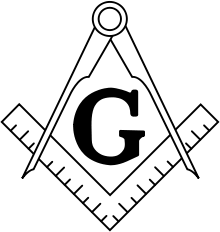Grande Loge Nationale Française
.jpg) | |
| Constituted | 1913 |
|---|---|
| Jurisdiction | France |
| Location | Paris, France |
| Website | Official website |
The Grande Loge Nationale Française (GLNF) is a French Masonic Grand Lodge. It was founded in 1913, by two lodges, "Le Centre des Amis" Lodge splitting from Grand Orient de France and "L'Anglaise" lodge, an independent lodge based in Bordeaux.[1] GLNF is based on monotheism and the 1929 precepts of regularity issued by the United Grand Lodge of England.
The all-male Grande Loge traditionnelle et symbolique Opéra split from the GLNF in 1958, as did the National French Lodge in 1968, and more recently the Grand Prieuré des Gaules.[2]
Rites
The GLNF was originally founded to allow the practise of the Rectified Scottish Rite, whose Christian and theist characteristics were unacceptable to the Continental obediences. Following the influx of a large number of English and American expatriates during the world wars, the Emulation Rite and York Rite (a term which, in the French context, refers to the blue lodge degrees as worked in America) were added to the lodge, primarily the former.
Following an influx of a large number of brethren from the Grande Loge de France breaking away in protest of that obedience's treaty with the GOdF, the Ancient and Accepted Scottish Rite became the most prevalent rite, even in the blue lodge degrees.
Following the research of a number of the brethren into the history of the Rectified Scottish Rite, interest grew in restoring the French Rite to regular freemasonry in France. This led ultimately to a patent being obtained in 1989 from the Supreme Council of the Modern Rite for Brazil, which traced its ancestry back to France from before the Great Schism of 1877, and which had always remained regular. The French Rite has grown considerably in the GLNF in the last 20 years and is now practised by about 15% of its lodges.
Recently, lodges have been added that work the Standard Scottish Rite, bringing to six the total number of rites worked in the jurisdiction.
Crisis from 2009
In December 2009 Grand Master François Stifani faced down a rebellion by members of his own Grand Lodge over 17 million Euros expended on political subscriptions.[3] The rebels went to the courts. In January 2011 Mlle Monique Legrand was designated by French legal authorities to manage the Grand Lodge, deepening a major internal crisis, and bringing international repercussions. Following the publication of the suspension of relations by most of the "Regular" European Grand Lodges[4] United Grand Lodge of England voted on 14 September 2011 to suspend relations with the GLNF, with several US Grand Lodges subsequently doing so as well.[5][6]
On 10 June 2012, in the Basel Declaration, five Grand Lodges in Switzerland, Belgium, Austria, Germany and Luxembourg withdrew recognition from Grande Loge Nationale Française, declaring the damage irremediable. The declaration encouraged Grande Loge de France to take the lead in rebuilding a basis for regular Freemasonry in France, offering assistance if it will sever its links with irregular obediences. The declaration also offered support to the ordinary brethren who simply want to continue their masonry.[7] On 12 September 2012, the United Grand Lodge of England followed suit, citing the schisms within GLNF, and stating that it was not in control of its own affairs.[8]
Shortly afterwards, Stifani resigned, being replaced in December by Jean-Pierre Servel. Legrand promptly handed back the administration of the order to Servel, leaving the organisation once more in charge of its own affairs.[9] Servel suspended, then expelled Stifani. Documents showed Stifani had pledged the allegiance of his Grand Lodge to Nicolas Sarkozy as early as January 2008.[10]
Repercussions of the dispute continued to isolate GLNF. Servel denied the legitimacy of the Basel Declaration, claiming the five Grand Lodges had no right to criticise or interfere with the internal affairs of another Grand Lodge.[11] A statement from UGLE in September 2013 recognised that progress had been made, but made it plain that there was still much to do, there was no immediate plan to re-recognise the French order, and the UGLE would be taking no part in GNLF's centenary celebrations.[12] At their Quarterly Communications (meetings) held on 5 June (Ireland), 11 June (England) and 12 June (Scotland) 2014 "the Home Grand Lodges each moved resolutions to restore recognition to the GLNF, which resolutions were accepted."[13]
References
- ↑ GLNF website Histoire de la GLNF, retrieved 19 October 2013
- ↑ GPDG history retrieved 23 August 2013
- ↑ L'Express François Koch, Guerre ouverte chez les francs-maçons (Open war amongst freemasons), 17 March 2010, retrieved 18 October 2013
- ↑ http://www.granloggiaregolareitalia.org./download/COMUNICATO_GLNF.pdf
- ↑ http://www.alafreemasonry.org/messages/secretary/frenchnational.pdf
- ↑ http://www.newjerseygrandlodge.org/Freemason%20Fall%202012F.pdf
- ↑ Pietre Stones English translation of the Basel Declaration.
- ↑ Freemasonry Today Statement of withdrawal of recognition
- ↑ L'Express François Koch, Jean-Pierre Servel ratifié GM de la GLNF, 1 December 2012, retrieved 18 October 2013
- ↑ L'Express François Koch, GLNF contre Stifani : une nouvelle lettre à Sarkozy, 7 January 2013, retrieved 18 October 2013
- ↑ L'Express François Koch, Servel réplique vertement aux 5 GL d’Europe, 12 July 2013, retrieved 18 October 2013
- ↑ Freemasonry Today Quarterly Communication, 11 September 2013, A statement by the Grand Chancellor Derek Dinsmore on the Grande Loge Nationale Française (GLNF), retrieved 18 October 2013
- ↑ Quarterly Communications, June 2014, Joint statement on Grande Loge Nationale Française (GLNF) Thursday, 12 June 2014
